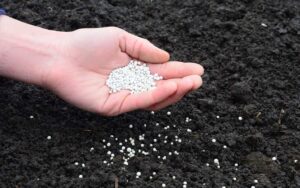Deep-banding fertilizer may have logistical benefits
Key result:
Overall, crop response was generally not linked to deep or shallow placement of phosphorus or potassium. Deep banding (5-6”) these nutrients at higher rates once every three years is an option if logistics make it a challenge to apply these products in a shallow band at the time of seeding.
Long-term direct seeding is associated with increased stratification of nutrients, with greater concentration of nitrogen (N), phosphorus (P) and potassium (K) in the top 2” of soil and lower concentrations below 2”. Nutrient stratification results from (a) the minimal mixing of near-surface applied fertilizers and (b) the cycling of nutrients from deep to shallow soil depths through above-ground plant decomposition of crop residues and resulting nutrient accumulation. Will deep banding of nutrients address any issues related to nutrient stratification?
Information to answer this question for Alberta soils and crop growing conditions is lacking. This project assessed whether deep banding of immobile nutrients (P, K and copper) can reduce nutrient stratification while improving nutrient uptake and crop production on land previously under direct seeding for >10 years. The overall objective is to increase the efficiency of P, K and copper fertilizers to improve the production of canola, peas, and wheat on direct-seeded fields.
The project compared (a) a deep banding application at 5-6” once at the beginning of the three-year study and (b) annual shallow banding at around 2” every year for three years. The deep-banding treatment used three times the recommended rate and shallow banding followed recommended rates at seeding. Researchers conducted small-plot replicated trials on farmland previously under direct seeding for at least 10 years at three sites (Lethbridge, Vegreville and Falher) representing diverse soil types and growing conditions of Alberta.

Project title, Principal investigator:
“Deep banding immobile nutrients under direct seeding systems to improve crop production and tackle nutrient stratification,”
Vance Yaremko, SARDA Ag Research
Funding:
Alberta Canola,
Alberta Innovates, Alberta Wheat
Results
Overall, while the biomass and yield of crops were occasionally increased in response to P, K and phosphorus-potassium-copper (PKCu) treatments in some study site years, crop response was generally not linked to deep or shallow placement of these nutrients. Sometimes deep banding was better, sometimes shallow banding was better. No conclusions could be drawn about nutrient stratification, likely because of the short three-year period of the trial.
Provincial websites for the Canadian Prairies suggest immobile nutrients placement below the depth of seeding may improve availability under dry conditions, because fertilizer is in a moist part of the root zone for a longer period. Also, some consultants recommend deep banding of immobile nutrients. However, the increased mechanical disturbance may add to variable costs, soil moisture loss, and soil erosion potential.
In view of earlier studies and results for this project, researchers suggest the following:
- Either method may be used in consideration of the logistics at the farm and prices for fertilizers.
- Deep banding will need another pass on the land that entails extra cost, but it may be helpful in the following situations: (1) If the available seeding drill does not have an adequate number of tanks to apply different fertilizers at seeding. (2) Less fertilizer to handle at seeding may reduce seeding time when delayed seeding usually reduces crop yield.
- If the available drill has a sufficient number of tanks and there is enough time for seeding, shallow annual applications are appropriate. It will save cost on the extra pass and avoid soil disturbance for deep placement.
- Deep banding could be accomplished in fall to take advantage of available time, dry soil conditions and possible fertilizer price advantages.
This trial raised more questions that researchers hope to answer with further research. Questions include: Can a producer bank phosphorus in the soil for future use by crops? Can a producer apply a three- or four-year supply of phosphorus in a shallow band instead of a deep band and not reduce crop production? How will these practices affect soil health in the long term?





